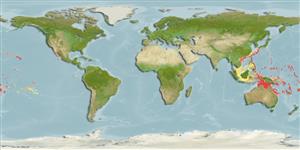Environment: milieu / climate zone / गहराई सीमा / distribution range
पारिस्थितिकी
समुद्री प्रवाल-भित्ति संयुक्त; गहराई सीमा 15 - 70 m (Ref. 9710), usually 15 - 70 m (Ref. 27115). Tropical; 22°C - 27°C (Ref. 27115); 35°N - 24°S
Western Pacific: Moluccas to Fiji, north to the Izu Islands and Taiwan (Ref. 5193), south to New Caledonia and the Great Barrier Reef. Recently recorded from Tonga (Ref. 53797).
आकार / वज़न / Age
परिपक्व अवधि: Lm ? range ? - ? cm
Max length : 13.0 cm TL पुल्लिंग / अलिंग; (Ref. 9710)
पृष्ठीय रीढ़ (सम्पूर्ण) : 10; पृष्ठीय सौफट रेज़ (सम्पूर्ण) : 18 - 20; गुदा कांटा: 3; ऐनल सौफट रेज़: 7.
Body shape (shape guide): short and / or deep; Cross section: compressed.
Occurs inshore near coral reefs (Ref. 7300). Also occurs in small groups near caves, ledges and drop-offs (Ref. 9710, 48635). Also a solitary species, sometimes in loose aggregations (Ref. 48635). Secretive, swims upside-down (Ref. 37816).
Life cycle and mating behavior
परिपक्व अवधि | पुनरुत्पत्ति | मछलीऔ का अंडे देना | अंडे | Fecundity | लार्वा
Masuda, H., K. Amaoka, C. Araga, T. Uyeno and T. Yoshino, 1984. The fishes of the Japanese Archipelago. Vol. 1. Tokai University Press, Tokyo, Japan. 437 p. (text). (Ref. 559)
IUCN Red List Status (Ref. 130435: Version 2025-1)
Threat to humans
Harmless
Human uses
मात्स्यिकी: कोई रुचि बग़ैर; जलजीवालय: व्यापारिक
साधन
Special reports
Download XML
इंटरनेट स्रोत
Estimates based on models
Preferred temperature (संदर्भ
123201): 24.8 - 29, mean 27.6 °C (based on 270 cells).
Phylogenetic diversity index (संदर्भ
82804): PD
50 = 1.0000 [Uniqueness, from 0.5 = low to 2.0 = high].
Bayesian length-weight: a=0.02512 (0.00987 - 0.06393), b=2.97 (2.74 - 3.20), in cm total length, based on LWR estimates for this (Sub)family-body shape (Ref.
93245).
Trophic level (संदर्भ
69278): 3.4 ±0.45 se; based on food items.
लौटाव (संदर्भ
120179): ऊंचा, न्यूनतम जनसंख्या दुगनी समय अवलागत 15 महीने। (Preliminary K or Fecundity.).
Fishing Vulnerability (Ref.
59153): Low vulnerability (10 of 100).
🛈
Nutrients (Ref.
124155): Calcium = 85.9 [48.0, 161.7] mg/100g; Iron = 0.81 [0.43, 1.51] mg/100g; Protein = 17.6 [15.7, 19.4] %; Omega3 = 0.135 [0.077, 0.229] g/100g; Selenium = 30.2 [15.6, 62.7] μg/100g; VitaminA = 131 [35, 559] μg/100g; Zinc = 1.34 [0.85, 2.01] mg/100g (wet weight);
